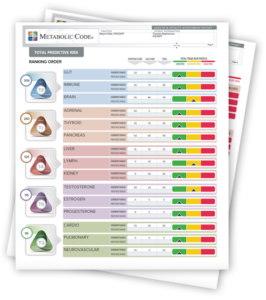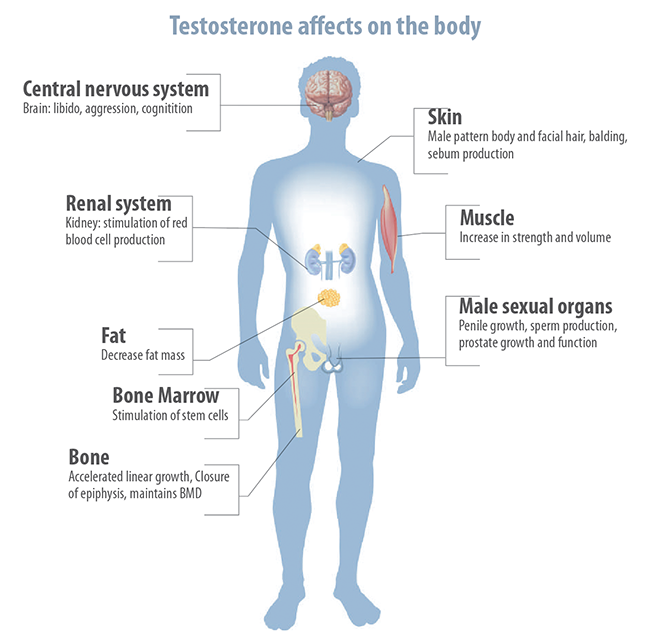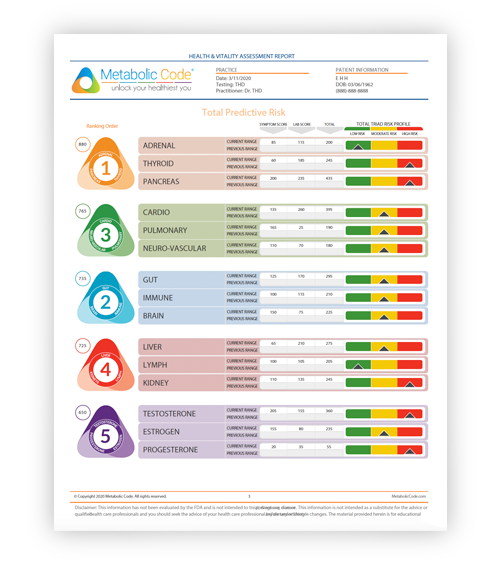TRIAD 5 – Potency
Metabolic Code® TRIAD 5™
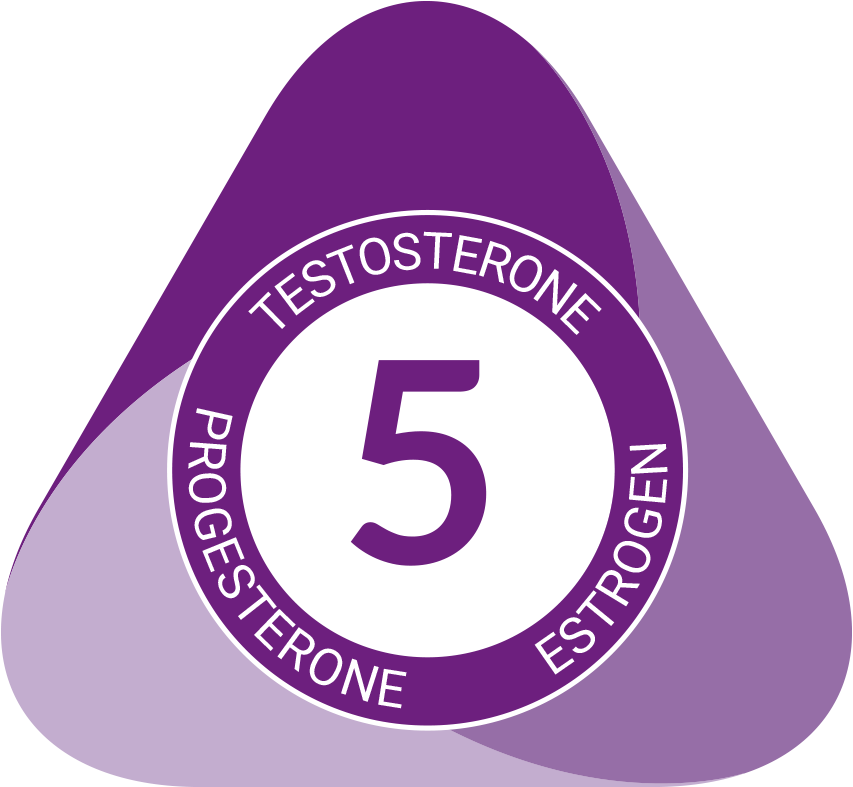
TRIAD 5: Potency
(Testosterone, Estrogen, Progesterone)
TRIAD 5: Potency
(Testosterone, Estrogen, Progesterone)
This TRIAD includes the reproductive hormones estrogen, progesterone, and testosterone. These hormones play a vital role in the human reproduction lifecycle. They confer a sense of potency, power, and self-esteem for both men and women. For men, production engenders a sense of reward while for women, reproduction gives them a sense of security.
Learn More About Each TRIAD 5 System
Testosterone
Estrogen
Progesterone
Testosterone
TESTOSTERONE (HORMONE)
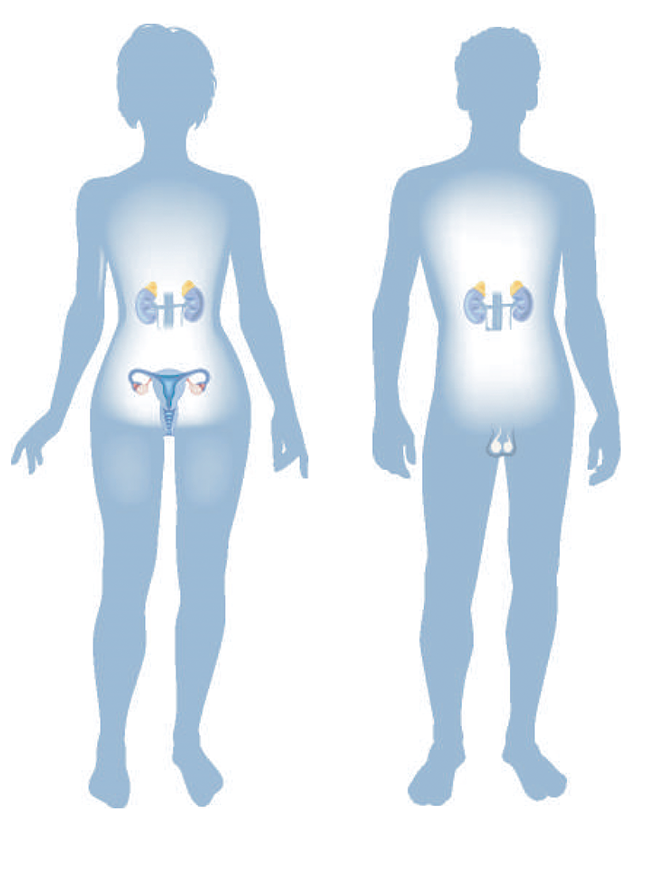
SUMMARY
Testosterone is a steroid sex hormone produced in the male and in the female.
Testosterone produces the male sexual characteristics, including body hair and sex organ development. In both men and women, testosterone is necessary for muscle growth and bone development and strength.
IMPORTANCE
As men and women age, their hormones change. This hormonal change can be slow and gradual or can be sudden, bringing with it health issues associated with aging. You could be noticing depression and mood changes, weight gain, achiness and joint stiffness, blood pressure changes, numbness or tingling in the toes, feet or hands, loss of muscle and strength, cognitive decline, blood sugar imbalances, dizziness and even changes in your sex drive. You may not realize these issues are related to changes in your hormones.
How your hormones are working in your body is influenced by the balance between different hormones – the interrelationship between the hormones, and whether your body is metabolizing (processing) them properly and if any environmental toxins are blocking their effects.
MORE INFORMATION:
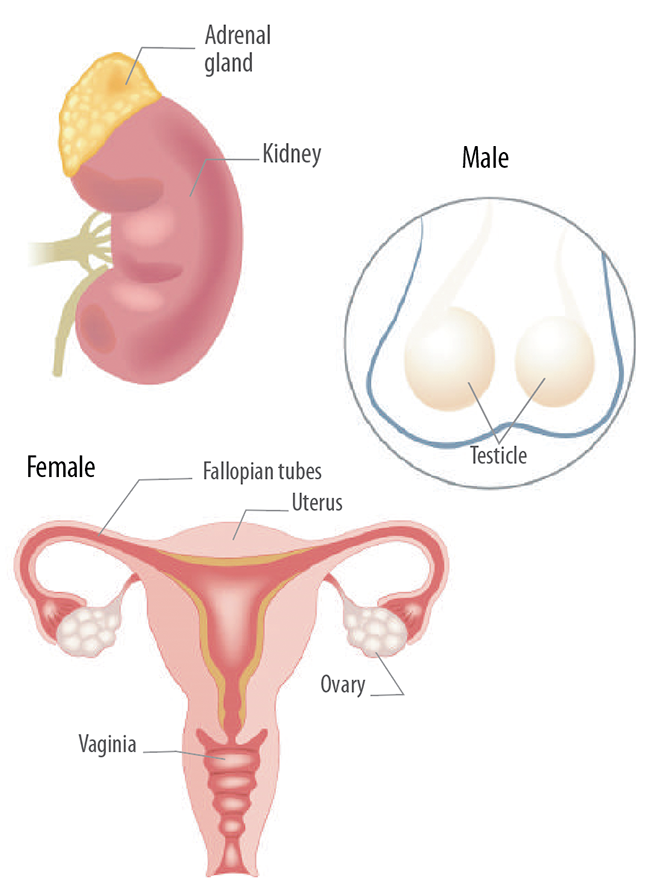
Testosterone is produced in the male in the testes and in women in the ovaries (to a much less extent), and in both male and female in the adrenal glands in small amounts. On average, adult males have approximately 7-8 times more testosterone than females.
The hypothalamus is triggered to release luteinizing hormone (LH) from the anterior pituitary gland, which signals the Leydig cells in the testes to produce testosterone, resulting in the development of male secondary sex characteristics.
Too much testosterone in women can lead to masculinization and weight gain. Declining testosterone levels are common in the aging process in both men and women.
Low levels have been reported in as many as 38.7% of men over 45 years of age, and in 20% of women. The age-related decline in testosterone in men can play a role in developing weight gain, insulin resistance and type 2 diabetes, erectile dysfunction and decreased libido, thyroid imbalances, cardiovascular conditions, memory and cognitive decline including Alzheimer’s disease, bone loss and loss of muscle mass and resulting increased risk of osteoporosis, sleep and immune problems, cancer and an increased the risk of death in adult men.
Stress and the release of the stress hormone cortisol is also a major contributor to a decline in testosterone. Studies support having healthy testosterone levels supports a healthy body composition in both men and women.
As men age, their serum hormone binding globulin (SHBG) starts to increase, also leading to a decrease in free testosterone while estrogen levels start to increase. The estrogen/testosterone imbalance is partly because aging men tend to convert more of their testosterone into estradiol, by means of the enzyme aromatase. Of the remaining testosterone, much of it is bound to SHBG, making it hard to use by the body. As long as free testosterone is low and the relative estrogen (estradiol and estrone) is high, a man will store fat around their belly, hence the “pot belly”. Low plasma levels of SHBG and free testosterone have been linked with increased insulin resistance and risk for type 2 diabetes in males.
Estrogen
ESTROGEN (HORMONE)
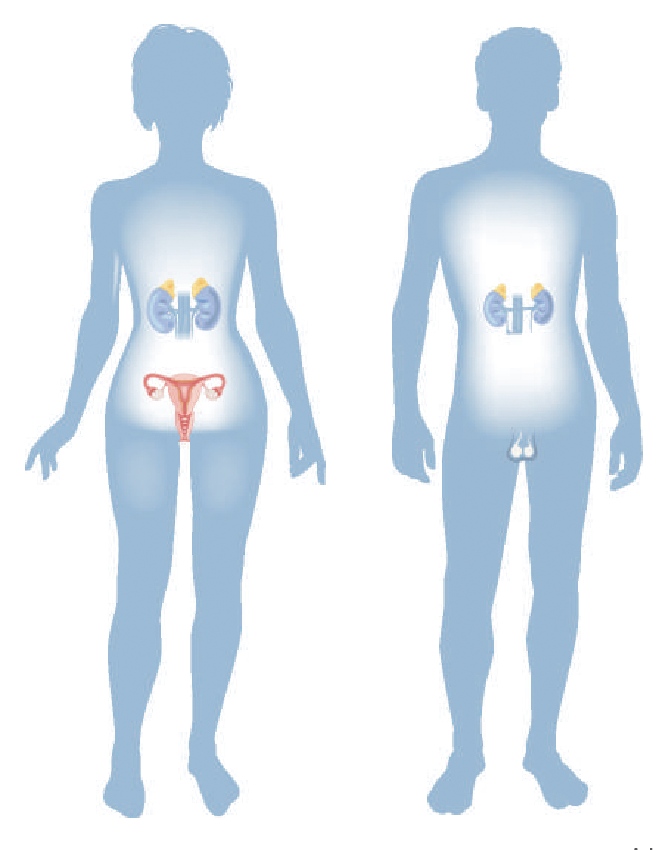
SUMMARY
Estrogen is a steroid hormone produced in the ovaries, adrenal glands and fat tissue in women and the testes, adrenals and fat tissue in men. Estrogen is thought of as a hormone that is involved in female reproduction, but it also occurs in males in smaller amounts and affects the growth, differentiation and function of many tissues in the body. Estrogen is a term that is used to collectively describe the hormones estradiol, estrone and estriol.
In the body, estrogens circulate mainly bound to the sex hormone binding globulin (SHBG) and only unbound (or “free”) estrogens can enter cells and lead to biological effects.
IMPORTANCE
As men and women age, their hormones change.
This hormonal change can be slow and gradual or can be sudden, bringing with it health issues associated with aging. You could be noticing depression and mood changes, weight gain, achiness and joint stiffness, blood pressure changes, numbness or tingling in the toes, feet or hands, loss of muscle and strength, cognitive decline, blood sugar imbalances, dizziness and even changes in your sex drive. You may not realize these issues are related to changes in your hormones. How your hormones are working in your body is influenced by the balance between different hormones – the interrelationship between the hormones, and whether your body is metabolizing (processing) them properly and if any environmental toxins are blocking their effects.
MORE INFORMATION:
Estrone (E1) is the main estrogen made by women after menopause and is associated with the development of breast, uterine and prostate cancer. Before menopause your body makes estradiol out of estrone in the ovaries. Once this stops estrone is no longer converted to estradiol. Once in menopause fat cells, the liver and Estrone (E1) is the main estrogen made by women after menopause and is associated with the development of breast, uterine and prostate cancer. Before menopause your body makes estradiol out of estrone in the ovaries. Once this stops estrone is no longer converted to estradiol. Once in menopause fat cells, the liver and the adrenal glands make estrone. Obese women have a higher rate of breast cancer, and increased estrone production is thought to be a significant contributing factor. Alcohol consumption also makes your body favor estrone production – being a reason for the association between alcohol intake and breast cancer.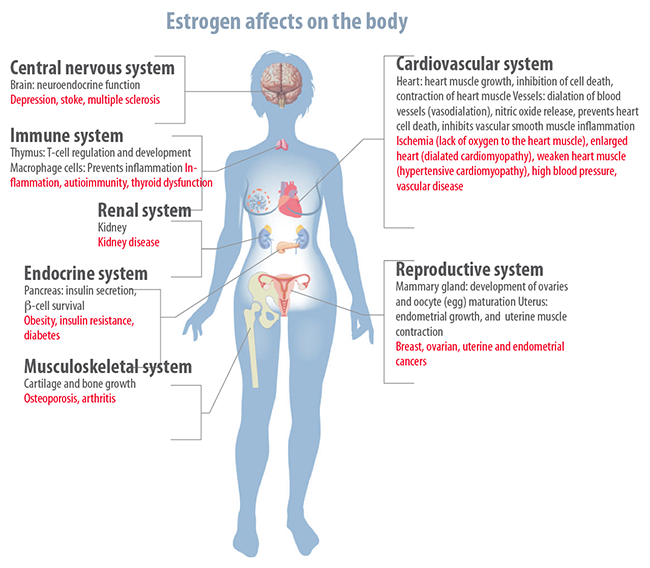
Estradiol (E2) the strongest estrogen, it is produced in the ovaries has many protective effects, including protecting bone health/density, improving growth hormone levels, improving blood vessel flexibility and keeping your blood from getting sticky, supporting memory/cognitive function and mood, supporting growth hormone release as well as improving your cholesteron/lipid profile. Estradiol is also the primary heart-protective estrogen. Too much estradiol can be associated with estrogen related cancers, but deficiencies can lead to osteoporosis, heart disease, dementia and other diseases of aging.
Estriol (E3) is the weakest of the three estrogens and has protective role in breast tissue health, along with vaginal and urethra tissue protective properties as well. It can help improve your cholesterol profile by increasing HDL and decreasing LDL so estriol is heart protective. Estriol also helps decrease hot flashes in women, protect the unrinary tract and plays a role in retention of bone density. It blocks the effects of estrone by occupying estrogen receptor sites, an important anti-cancer mechanism.
The major method that estrogen affects the body depends on its metabolism. The metabolism of estrogens takes place mainly in the liver, allowing the estrogen to be detoxified and excreted from the body. Estrogens are also metabolized in your intestines, and are dependent upon the health of the gastrointestinal tract.
Estrogens convert into many metabolites. Estrone, for example, may convert into three different forms:
- 2-hydroxyestrone – protective
- 4-hydroxyestrone – cancer causing and active
- 16-alpha-hydroxyestrone – cancer causing and active
Research has identified 2-hydroxyestrone as a “good estrogen,” while 16-alpha-hydroxyestrone and 4-hydroxyestrone (“bad” estrogens) have been associated with the development of certain types of cancer, like breast and ovarian with uterine fibroids, ovarian cysts and fibrocystic breasts. By increasing the ratio of the good form to the bad form you can reduce your chances of developing hormonal related cancers like breast, uterine and ovarian.
As women age their estradiol levels goes down and their estrone levels increase and in men their relative estradiol and estrone levels go up. Both men and women will make more estrogens if they accumulate visceral (belly) fat.
Excessive estrogen makes cells grow which makes tissues grow, affecting the ovaries and breast in women and the prostate tissue in men. Estrogen is needed particularly in women to make serotonin receptors function in the brain, affecting mood and increasing anxiousness and depression. Serotonin is the “calming” brain chemical. Estradiol has heart-protective effects, so as women enter menopause and loose their estradiol production, they actually have higher heart disease risks than men.
Estrogen also helps keep bones strong, as women will lose up to 25% of their bone density in the first year of menopause. Skin wrinkling is accelerated as estrogen is lost from a women’s body and cognitive function- critical thinking and short-term memory are eroded with the loss of estrogen production. Symptoms such as vaginal dryness and urinary leakage can also occur.
Drugs that can decrease levels of estradiol include:
- Oral contraceptives
- Anticonvulsants
- Clomiphene (Clomid, Serophene)
Too much estrogen in men, particularly estradiol, can lead to increased risk of stroke and heart disease, loss of sexual desire and function, prostate problems and increased belly fat/weight gain. High estradiol levels in ovulating women can lead to decreases in pregnancy rates but lowers the incidence of heart disease in postmenopausal women.
Drugs that can increase estradiol levels include:
- Corticosteroids (including prednisone, cortisone, hydrocortisone and methylprednisolone)
- Antibiotics including ampicillin and tetracycline
- Estrogen-containing drugs, including hormonal replacement therapy
- Phenothiazine antipsychotics (including chlorpromazine and promethazine)
Also, environmental toxins like xenoestrogens found in pesticides, phthalates in cosmetics and BPA in plastic bottles can lead to signs of estrogen dominance and imbalance other hormones.
Various lifestyle and environmental factors can influence the production, binding, metabolism and function of estrogens in men and women, including:
- Genetics
- Age
- Poor diet, high in refined carbohydrates like whitebreads, sugars and low in vegetables, low fiber and high saturated fat
- Excessive alcohol consumption
Poor glycemic control and insulin signaling sensitivity - Certain medications, including hormone replacement therapy (HRT) and oral contraceptives (OC’s)
- Exposure to environmental contaminants (xenoestrogens) such as pesticides, found in industrial chemicals and foods contaminated with agricultural hormones
- Excessive visceral (belly) fat
Progesterone
PROGESTERONE (HORMONE)
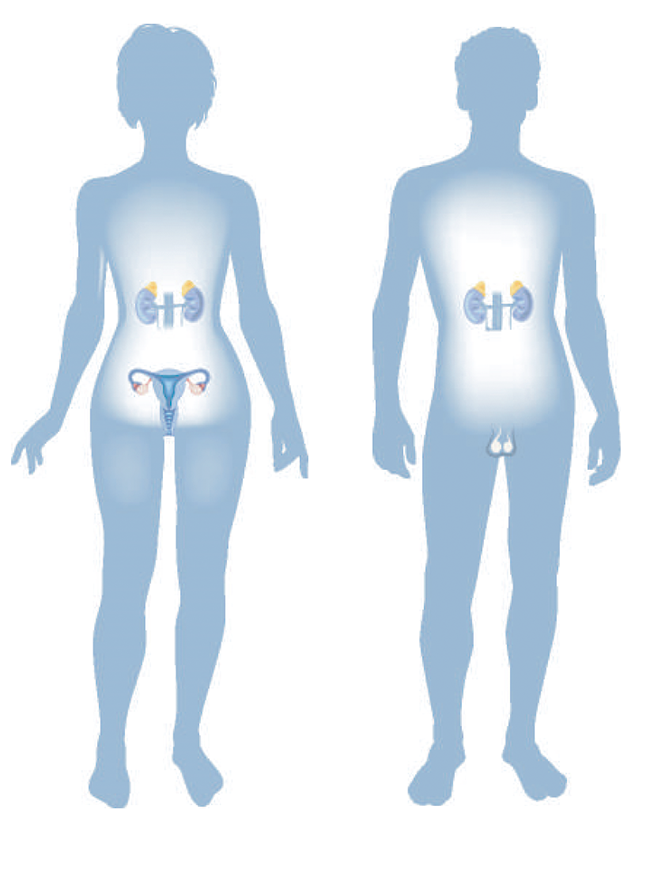
SUMMARY
Progesterone is a steroid sex hormone made from cholesterol. Progesterone works in conjunction with estrogen as the main sex hormones responsible for the menstrual cycle in women and helps prepare the body for pregnancy.
IMPORTANCE
As men and women age, their hormones change. This hormonal change can be slow and gradual or can be sudden, bringing with it health issues associated with aging. You could be noticing depression and mood changes, weight gain, achiness and joint stiffness, blood pressure changes, numbness or tingling in the toes, feet or hands, loss of muscle and strength, cognitive decline, blood sugar imbalances, dizziness and even changes in your sex drive. You may not realize these issues are related to changes in your hormones. How your hormones are working in your body is influenced by the balance between different hormones – the interrelationship between the hormones, and whether your body is metabolizing (processing) them properly and if any environmental toxins are blocking their effects.
MORE INFORMATION:
Progesterone is a steroid sex hormone made from cholesterol. Progesterone is a hormone produced mainly by the ovaries and the placenta in women during the period when they are able to bear young. This hormone can also be produced by the adrenal glands in both the females and males by the testes in males. Adult males have levels similar to those in women during the follicular phase of the menstrual cycle.
Progesterone works in conjunction with estrogen as the main sex hormones responsible for the menstrual cycle in women and helps prepare the body for pregnancy. Progesterone levels rise during the middle of the cycle, while estrogen increases in the first half of a menstrual cycle. Progesterone helps to prepare the uterus for implantation with a healthy fertilized egg and supports pregnancy in its early stages. If no implantation occurs, progesterone levels drop, and another cycle begins.
Progesterone helps make other steroid sex hormones, including dehydroepiandosterone (DHEA), testosterone and estrogen. Progesterone also helps make cortisol, the stress hormone. Progesterone receptors are found in high concentrations in the brain, where it acts to protect nerve cells and supports the myelin sheath that covers neurons. It helps to relax the nervous system to improve sleep and stimulates bone growth for maintaining bone health.
For women, it is important to compare the relationship between estradiol and progesterone in evaluating menopausal symptoms such as hot flashes, mood disorders, and aging skin. Breast cancer is reported to be less common in women with adequate progesterone levels. Men also need a balanced progesterone to estrogen level. Excessive estrogen and deficient progesterone leads to estrogen dominance in both men and women. Too much estrogen and too little progesterone has been associated in women with heart disease, obesity, the development of certain types of cancer, like breast and ovarian, ovarian cysts, PCOS or polycystic ovary disease, fibrocystic disease and uterine fibroids. Decreased levels of progesterone are often seen in those with chronic stress, insufficient exercise, low thyroid hormone levels, a diet high in refined sugar and saturated fats, in those on antidepressants, and those with a deficiency of vitamin A, B6, C or zinc.
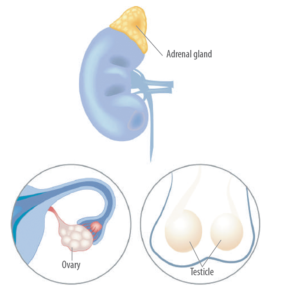
The stress hormone cortisol is made from progesterone. If your stress levels are high, then more cortisol is produced, the less progesterone is available, leading to more estrogen to progesterone than is healthy. Less progesterone in men means less testosterone is being made, which can lead to low testosterone levels and metabolic imbalances (see testosterone sheet). Environmental toxins like xenoestrogens (hormone-disruptors) commonly found in pesticides, phthalates in cosmetics and BPA in plastic bottles can lead to signs of estrogen dominance and decreased progesterone.
Symptoms of low progesterone include:
- Anxiety/Depression
- Trouble sleeping
- Fibrocystic breasts
- PMS
- Premenstrual headaches
- Bones loss
Elevated levels of progesterone compared to estrogen can lead to insulin and blood sugar problems. Excess progesterone can also lead to anxiety, as progesterone is converted in the body into cortisol, the stress hormone. Too much progesterone can cause breast tenderness, depression, fatigue, low sex drive, vaginal dryness, and more. High progesterone levels may indicate pregnancy. Synthetic progestins are found in birth-control pills, in hormones given during menopause for replacement therapy, or in medications to correct abnormal bleeding problems during menses. Taking these medications may lead to an increased progesterone level.
If the progesterone to estrogen ratio is too high you will store fat and tend toward insulin resistance.
Too much progesterone can lead to:
- Elevated cortisol/stress hormone
- Increased cravings
- Reduced growth hormone
- Immune imbalances
How the Metabolic Code® Works
1. Labs & Lifestyle Questionnaire
Take our signature comprehensive lab panel and lifestyle questionnaire to identify where your systems are currently out of balance.
2. Personalized Supplement Program
Based on your results take pharmaceutical grade and clinically tested supplements that are compounded specifically to address each TRIAD.
3. Metabolic Code Diet
Based on your profile you will get a detailed Metabolic Code Diet program that will significantly benefit your results and help you reach a healthy weight.
Request a Sample Report
Questionnaire, Labs and Biometric
Thee most comprehensive personal assessment available.
